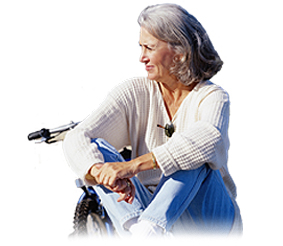Hip Pain SmartSiteTM | ||||||||||||||||||
Sports injuries, bursitis, and strainsDescriptionMany exercises, stretches, and other methods can treat the causes of hip pain. BursitisBursitis is the swelling and irritation of a bursa. A bursa is a fluid-filled sac that acts as a cushion between muscles, tendons, and joints. When you have bursitis of the hip, you may notice:
Muscle strainsA strain is when a muscle becomes damaged because of pulling or twisting. This painful injury, also called a "pulled muscle," can be caused by a quick twist or pull of a muscle, overuse of a muscle, or an accident. A muscle strain may be acute (start suddenly and more painfully) or chronic (be present over a long period of time). The injury may be from over-stretching or from contracting (or tightening) the muscle too strongly or too many times. The muscles are often grouped based on which direction they move your hip.
When you have a muscle strain around your hip, you may notice:
TendinitisTendons are tough bands of tissue that connect muscles to bones. Tendinitis refers to swelling and irritation of a tendon. Tendinitis may be acute (start suddenly and more painfully) or chronic (be present over a long period of time). Tendinitis can be caused by a quick twist or pull or by overuse of a muscle. As a person ages, their tendons become less elastic, or stretchable, and tendinitis is more likely to occur. Iliotibial band syndrome is a hip disorder related to irritation or injury of the thick band that runs from the side of your hip to the outside of your knee. When you have tendinitis, you may notice:
Labral tearsThe hip joint is a ball (head of your thigh bone, called a femur, or leg bone) and socket (part of the pelvic bone) type of joint. Very strong cartilage, called the labrum, attaches along the rim of the hip socket. The labrum makes the socket a little deeper and provides stability to your hip joint. It also helps cushion your hip joint. A torn labrum may happen:
When you have a torn labrum, you may notice:
Snapping hip syndromeSnapping hip syndrome is when you hear or feel a snapping sensation when walking, getting up, or swinging your leg around. The snapping is from a tendon moving over a part of a bone in or near your hip. Most of the time there is no pain. Younger athletes and dancers may complain of this problem. Bursitis may develop and cause some pain. If the pain becomes more severe, or your hip joint seems to catch or lock up, you may have a more serious injury in your hip joint. Impingement syndrome or femeroacetaublar impingement (FAI)The hip joint is made up of a ball (the head of the femur, or leg bone) and socket (part of the pelvic bone). Extra bone may grow on either the ball or the socket because of arthritis. As a result, when your hip moves to its range of motion, the cartilage or the labrum is pinched (or impinged) by the extra bone. The cartilage and the labrum help to cushion the hip joint. Over time, they are damaged and may wear away or even tear. This problem may also be called femoroacetabular impingement (FAI). The extra bone growth can be normal, or it may result from trauma, fractures, and certain hip problems occurring in childhood. Repeated stress from playing certain sports may also cause this syndrome. Hockey, soccer, and football players, as well as runners, may develop this problem. When you have impingement syndrome, you may notice that:
When the hip truly locks, it is a sign of a tear or other damage to the labrum. | ||||||||||||||||||
| ||||||||||||||||||
Review Date: 12/31/2018 Reviewed By: C. Benjamin Ma, MD, Professor, Chief, Sports Medicine and Shoulder Service, UCSF Department of Orthopaedic Surgery, San Francisco, CA. Also reviewed by David Zieve, MD, MHA, Medical Director, Brenda Conaway, Editorial Director, and the A.D.A.M. Editorial team. View References:  The information provided herein should not be used during any medical emergency or for the diagnosis or treatment of any medical condition. A licensed medical professional should be consulted for diagnosis and treatment of any and all medical conditions. Links to other sites are provided for information only -- they do not constitute endorsements of those other sites. No warranty of any kind, either expressed or implied, is made as to the accuracy, reliability, timeliness, or correctness of any translations made by a third-party service of the information provided herein into any other language. © 1997- A.D.A.M., a business unit of Ebix, Inc. Any duplication or distribution of the information contained herein is strictly prohibited. | ||||||||||||||||||
A.D.A.M. content is best viewed in IE9 or above, Firefox and Google Chrome browser. | ||||||||||||||||||












